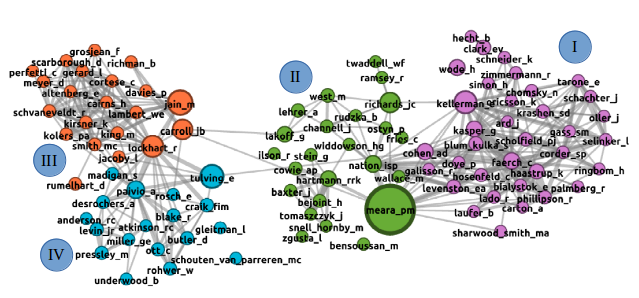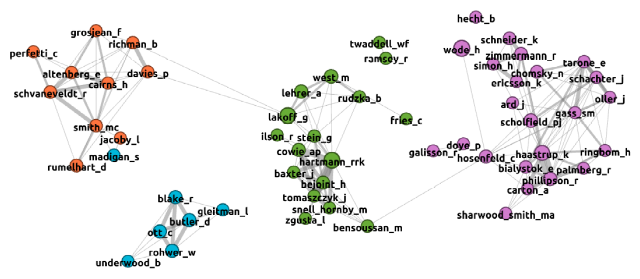 |
||
Lognostics Maps 1987 |
||

|
This map shows the co-citation patterns between authors who are cited in the 1986 research listed in the VARGA database. Weaker co-citation links have been removed in the interests of simplicity.
data source: VARGA 1987: data analysis: November 2019 98 sources are cited in at least four of the papers in the 1987 data set. This number is very close to the figure of 100 sources usually that is conventionally used for co-citation analysis. This inclusion threshold for this analysis is four citations in the data set. This figure is higher than the one used for the earlier analyses in this series. The main point to note in this map is that the number of papers included in the 1987 data set is about 20% higher than the figure for 1986: (1986: 81 papers, 1987: 99 papers). This is partly due to the publication of special thematic issues of journals and some books of thematically related papers. However, the number of sources that meet our inclusion threshold is slightly smaller than the 1986 data set, mainly because we have raised the inclusion threshold to four citations.
Gephi identifies four main clusters in this map.
The largest cluster, Cluster I on the Eastern edge of the map, seems to be the main-stream of L2 vocabulary research at this time. European research figures as an important theme in this cluster, with strong sub-clusters of Danish research (Faerch, Kasper, Haastrup), Israeli research (Laufer, Levenston, Blum-Kulka, Cohen), and US research (Krashen, Oller, Gass, Tarone). French language research is represented by Galisson, and German language research by Zimmerman, Schneider and Doyé. Thematically, this cluster seems to be strongly oriented towards transfer research (Ringbom, Kellerman) and error analysis (Corder, Selinker and Scholfield). Hecht, Wode and Eve Clark are detached members of this cluster, sources who are frequently cited in the data set, but not consistently co-cited with other sources. The main split in this map runs between clusters III and IV on the one hand, and clusters I and II on the other. Only a handful of of co-citation links run across this divide (Carroll~Lakoff, Carroll~Meara and Tulving~Cohen). Cluster I and Cluster III show very strong internal links, while Cluster5 II and cluser IV are made up of sources who are less frequently cited along-side each other. None of the sources in Cluster I is co-cited with any source in Cluster III or Cluster IV, and few of them have any co-citation lionks with the sources in Cluster II. Richards, Nation and Meara provide the main links between Cluster II and Cluster I As in earlier maps, the majority of the influences in the 1987 map are new sources who did not appear in the research outputs of previous years. The new entrants for 1987 are shown in the map below.
new entries in the 1987 data set
All four of the clusters that we identified in the main map contain a substantial number of new sources, but this effect is particularly noticeable in Cluster I and Cluster II. Cluster I has 27 new sources who have not appeared in our earlier maps. The strong Scandinavian research that we noted as a new presence in the 1986 map has been strengthened by the arrival of Ringbom, Palmberg, Haastrup, and Phillipson. A new group of North American SLA researchers also forms part of this cluster (Tarone, Schachter, Oller Ard and Gass). Zimmerman provides the focus for a new group of German researchers.
|
© 2019 Paul Meara
